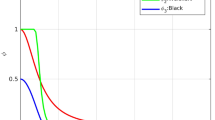Abstract
Computing an optical flow field using the classical image motion constraint equation \(I_x u + Iy\upsilon + I_t = 0,\) is difficult owing to the aperture problem and the need to compute the image intensity derivatives via numerical differentiation—an extremely unstable operation. We integrate the above constraint equation over a significant spatio-temporal support and use Gauss's Divergence theorem to replace the volume integrals by surface integrals, thereby eliminating the intensity derivatives and numerical differentiation. We tackle the aperture problem by fitting an affine flow field model to a small space-time window. Using this affine model our new integral motion constraint approach leads to a robust and accurate algorithm to compute the optical flow field. Extensive experimentation confirms that the algorithm is indeed robust and accurate.
Similar content being viewed by others
References
Anandan, P. 1989. A computational framework and an algorithm for the measurement of visual motion. International Journal of Computer Vision, 2:283–310.
Barron, J., Fleet, D., and Beauchemin, S. 1994. Performance of optical flow techniques. International Journal of Computer Vision, 12(1):43–79.
Burden, R., Faires, J., and Reynolds, A. 1978. Numerical Analysis. Prindle, Weber & Schmidt: Boston, MA.
Fennema, C.L. and Thompson, W.B. 1979. Velocity determination in scenes containing several moving objects. Computer Graphics and Image Processing, 9:301–315.
Fleet, D.J. and Jepson, A.D. 1990. Computation of component image velocity from local phase information. International Journal of Computer Vision, 5:77–104.
Glazer, F. 1987. Hierarchical motion detection, Ph.D. Dissertation, University of Massachusetts, Amherest, MA.
Gupta, N. 1993. Recovering Shape and Motion from a Sequence of Images, Ph.D. Dissertation, University of Maryland, College Park, Md, 1993.
Gupta, N., Raghavan, S., and Kanal, L. 1993. Robust recovery of image motion. In Proc. Asian Conference on Computer Vision, Osaka, Japan.
Gupta, N. and Kanal, L. 1995. 3D motion estimation from motion field, Artificial Intelligence, 78:45–86.
Hay, J.C. 1960. Optical motions and space perception: An extension of Gibson's analysis. Psychological Review, 73(6):550– 565.
Heeger, D.J. 1988. Optical flow using spatiotemporal filters. International Journal of Computer Vision, 1:273–302.
Hildreth, E.C. 1984. Computations underlying the measurement of visual motion. Artificial Intelligence, 23:309–354.
Horn, B.K.P. and Schunck, B.G. 1981. Determining optical flow. Artificial Intelligence, 17:185–203.
Horn, B.K.P. 1986. Robot Vision. MIT Press.
Kreyszig, E. 1967. Advanced Engineering Mathematics, John Wiley & Sons, Inc.
Longuet-Higgins H.C. and Prazdny, K. 1980. The interpretation of a moving retinal image. Proc. Royal Soc. of London, B208:385–397.
Longuet-Higgins, H.C. 1981. A computer algorithm for reconstructing a scene from two projections. Nature, 293:133–135.
Lucas, B.D. 1984. Generalized image matching by the method of differences, Ph.D. Dissertation, Dept. of Computer Science, Carnegie-Mellon University.
Nagel, N.N. 1981. Representation of moving rigid objects based on visual observations. IEEE Computer, pp. 29–39.
Nagel, H.H. and Enkelmann, W. 1986. An investigation of smoothness constraints for the estimation of displacement vector fields from image sequences. IEEE Trans. PAMI, 8:565–593.
Negahdaripour, S. and Lee, S. 1992. Motion recovery from image sequences unsing only first order optical flow information. International Journal of Computer Vision, 9(3):163–184.
Poggio, T. and Reichardt, W. 1976. Visual control of orientation behavior in the fly: Part II towards underlying neural interactions, Quarterly Reviews in Biophysics, 9:377–438.
Raghavan, S., Gupta, N., and Kanal, L. 1992. Discontinuity preserved image motion estimation. In Proc. International Conference on Pattern Recognition, The Hague, The Netherlands.
Schunck, B.G. 1984. Motion segmentation by constraint line clustering. In Proc. IEEE Workshop on Computer Vision: Representation and Control, pp. 58–62.
Tsai, R.Y. and Huang, T.S. 1981. Estimating 3-D motion parameters of a rigid planar patch. IEEE Trans. ASSP, 29(6):1147– 1152.
Verri, A. and Poggio, T. 1987. Against quantitative optical flow. In Proc. International Conference on Computer Vision, pp. 171–180.
Waxman, A.M. and Ullman, S. 1985. Surface structure and three-dimensional motion from image flow kinematics. Intern. J. Robot. Res., 4:95–108.
Author information
Authors and Affiliations
Rights and permissions
About this article
Cite this article
Gupta, N., Kanal, L. Gradient Based Image Motion Estimation Without Computing Gradients. International Journal of Computer Vision 22, 81–101 (1997). https://doi.org/10.1023/A:1007931911114
Issue Date:
DOI: https://doi.org/10.1023/A:1007931911114




